Journal of Digital Technologies and Law
Статьи журнала - Journal of Digital Technologies and Law
Все статьи: 206
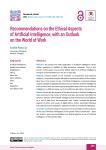
Статья научная
Objective: the spread and wide application of Artificial Intelligence raises ethical questions in addition to data protection measures. That is why the aim of this paper is to examine ethical aspects of Artificial Intelligence and give recommendations for its use in labor law. Methods: research based on the methods of comparative and empirical analysis. Comparative analysis allowed to examine provisions of the modern labor law in the context of use of Artificial Intelligence. Empirical analysis made it possible to highlight the ethical issues related to Artificial Intelligence in the world of work by examining the disputable cases of the use of Artificial Intelligence in different areas, such as healthcare, education, transport, etc. Results: the private law aspects of the ethical issues of Artificial Intelligence were examined in the context of ethical and labor law issues that affect the selection process with Artificial Intelligence and the treatment of employees as a set of data from the employers’ side. Author outlined the general aspects of ethics and issues of digital ethics. Author described individual international recommendations related to the ethics of Artificial Intelligence. Scientific novelty:this research focused on the examination of ethical issues of the use of Artificial Intelligence in the specific field of private law – labor law. Authors gave recommendations on ethical aspects of use of Artificial Intelligence in this specific field. Practical significance: research contributes to the limited literature on the topic. The results of the research could be used in lawmaking process and also as a basis for future research.
Бесплатно
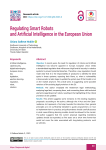
Regulating Smart Robots and Artificial Intelligence in the European Union
Статья научная
Objective: In recent years, the need for regulation of robots and Artificial Intelligence has become apparent in Europe. European Union needs a standardized regulation that will ensure a high level of security in robotics systems to prevent potential breaches. Therefore a new regulation should make clear that it is the responsibility of producers to identify the blind spots in these systems, exposing their flaws, or, when a vulnerability is discovered in a later stage, to update the system even if that model is not on the market anymore. This article aims at suggesting some possible revisions of the existing legal provisions in the EU. Methods: The author employed the Kestemont legal methodology, analyzing legal text, comparing them, and connecting them with technical elements regarding smart robots, resulting in the highlighting of the critical provisions to be updated. Results: This article suggests some revisions to the existing regulatory proposals: according to the author, although the AI Act and the Cyber-resilience Act represent a first step towards this direction, their general principles are not sufficiently detailed to guide programmers on how to implement them in practice, and policymakers should carefully assess in what cases lifelong learning models should be allowed to the market. The author suggests that the current proposal regarding mandatory updates should be expanded, as five years are a short time frame that would not cover the risks associated with long-lasting products, such as vehicles. Scientific novelty: The author has examined the existing regulatory framework regarding AI systems and devices with digital elements, highlighted the risks of the current legal framework, and suggested possible amendments to the existing regulatory proposals. Practical significance: The article can be employed to update the existing proposals for the AI Act and the Cyber-resilience Act.
Бесплатно
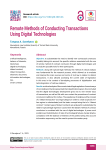
Remote Methods of Conducting Transactions Using Digital Technologies
Статья
Objective: to substantiate the need to identify new contractual constructs (models) taking into account the specific relations associated with the use of remote method of contract conclusion through digital technologies and to study the possible risks for their participants. Methods: along with special legal methods, the method of critical analysis was fundamental for the research process, which allowed us to evaluate and interpret the main sources and norms of civil law in relation to distant transactions. It also allowed assessing the current state of legislation in this area in the context of developing processes of digitalization and technologization of civil-law relations. Results: a critical analysis of the current state of legal regulation of remote ways of concluding contracts is presented, their classification is given. It is concluded that the digital technologies development gives rise to new remote ways of transactions, as well as fills with new content the procedures of contract conclusion, traditional for civil law. The expediency of singling out the concept of a “distant transaction” as a legal category in order to create a special civil-law regime is substantiated, and the basic concept being that of a “distant contract”. Certain types of distant contracts are analyzed to substantiate the need for special legal regimes in cases when the distant method of contract conclusion is combined with the use of digital technologies. It poses such problems as the distribution of risks of technological failures, hacker attacks, compliance with the balance of interests of the parties taking into account information asymmetry, and the need to protect the weaker party. Scientific novelty: an attempt is made to define such concepts as a “distant contract” and a “distant transaction” and to identify their features. The expediency is substantiated of considering a distant contract as a separate legal construction (model) of the contract. Within this framework, a special legal regime should be developed and fixed, which can be extended to unilateral distant transactions. The problems of legal regulation caused by the use of information technologies are formulated, and legal constructions for their solution are proposed. Practical significance: the final conclusions and proposals can be used both in contractual practice by the participants of civil turnover and for the normative consolidation of the concept and features of “distant contract”, “distant transaction”. A special legal regime can be created, taking into account the specificity generated by the use of digital technologies.
Бесплатно
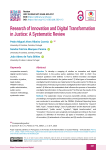
Research of Innovation and Digital Transformation in Justice: A Systematic Review
Статья
Objective: To develop a mapping of studies on innovation and digital transformation in the justice sector, publishes from 2001 to 2022. Five research questions were defined: 1) How to define innovation and digital transformation introduced in the justice sector? 2) What types of innovations and digital transformations are implemented in the justice sector? 3) What are the objectives of introducing innovation and digital transformation in the justice sector? 4) What are the antecedents that influence the process of innovation and digital transformation in the justice sector? 5) What are the results of the innovation and digital transformation process in the justice sector? Methods: The systematic review of sources (scientific articles, conference proceedings, monographs and institutional documents) presented in this paper was conducted in accordance with the PRISMA (Preferred Reporting Items for Systematic Reviews and Meta-Analyses) protocol. Selected by “research field”, “topic”, “research design”, “year of publication” and the keywords “public administration”, “public sector”, “e-justice”, “digital transformation”, and “innovation”, the sources were analyzed and evaluated according to five main aspects: (1) definition of innovation; (2) types of innovation; (3) objectives of innovation; (4) antecedents of innovation; and (5) results of innovation. Results: The heuristic model for studying innovation in the public sector developed by Vries et al. (2015) was adapted and applied to the research field of justice. The adaptation of the heuristic model allowed forming the following areas of analysis: contextual antecedents in justice; institutional antecedents in justice; characteristics of innovation and digital transformation in justice; individual antecedents in justice; types of innovation and digital transformation in justice; results of the process of innovation and digital transformation in justice. Scientific novelty: a comprehensive review of the literature in the field of innovation and digital transformation in justice is presented by adapting the approach to conducting systematic studies of the literature in the social sciences. It helped to identify gaps and define directions for further research in the given field, including the activation of comparative legal research, expansion of the methodological base, reliance on the theories of public administration, etc. Practical significance: the obtained results allow forming a heuristic map of innovation and digital transformation in justice, create antecedents (contextual, institutional and individual) and the basis for future empirical research in the field of justice, analysis, evaluation and improvement of public policy in the field of innovation and digital transformation in this area.
Бесплатно
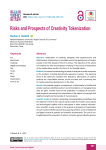
Risks and Prospects of Creativity Tokenization
Статья
Objective: tokenization of creativity, alongside with cryptoeconomy and Web3 network infrastructure, is a notable trend in the development of modern society in the third decade of the 21st century. The objective of this article is to explore the risks and prospects emerging in the process of disposition of the creative labor results in the form of non-fungible tokens. Methods: the research methodology is based on analysis of varied viewpoints on the problem, including diametrically opposing concepts. The opposing views of the observers manifest their attitude to tokenization of creative products as a speculative scheme, on the one hand, and a promising tool of creative industries development, on the other. Results: the probable negative consequences of tokenization of intellectual activity results are identified; author’s recommendations on managing these risks are given. Another result of this publication is analysis of economic-legal prospects stemming from tokenization of the objects of copyright and neighboring rights by the example of musical pieces. Scientific novelty: it consists in presenting and substantiating a hypothesis that the relations formed in the musical industry under the modern sociocultural and technological realities will be reproduced in other creative industries. Also, scientific novelty consists in the analysis of prospects of tokenization of such results of intellectual activity as gaming artifacts, works of traditional and digital visual arts, patents and scientific achievements. The use of non-fungible tokens the ecosystem of network computer games will allow gamers to buy and sell rights to game pieces autonomously from game publishers. Tokenization of industrial property objects and individualization means will ensure protection of intellectual rights of their authors while waiting for the issuance of a state protection document. In the modern society, there will be many of those wishing to become an owner of a token for a scientific work, as the popularity of science and innovations is constantly growing in developed countries. Ownership of a token for a scientific work will be regarded a moral investment, increasing the prestige and status of its owner. Tokens for scientific works have a high potential as a means of measuring value in a post-economic society. Practical significance: it consists in the description of innovative means of using creative products and business models based on tokenization of the results of intellectual activity, ready to be implemented in practice.
Бесплатно
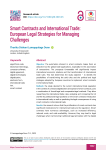
Smart Contracts and International Trade: European Legal Strategies for Managing Challenges
Статья
Objective: The automation inherent in smart contracts makes them an attractive tool for global trade applications, especially for the automation of transactions. The prospects foreseeable will significantly impact international economic relations and the transformation of international trade rules. This fact determines the study objective – to identify the possibilities of transforming the said rules and the political and legal strategies adopted by European countries to implement smart contracts in international trade. Methods: the study, devoted to the current international trade regulation in the context of contracts digitalization and spread of smart contracts, uses a combination of formal-legal and comparative-legal methods. They allow researching the international trade rules, analyzing and comparing the UK and the EU political and legal positions on the smart contracts introduction in international trade, as well as predicting the legal consequences of using smart contracts in international trade. Results: the research shows that the proliferation of smart contracts has significant implications for international trade and its regulation. Smart contracts have numerous advantages, such as increased efficiency, reduced costs, and wide availability. However, they may lead to legal challenges when harmonizing traditional legal principles with the digital environment, in particular concerning the authentication of subjects, enforceability under specific circumstances of a case, and jurisdictional issues. Scientific novelty: the current literature on the transformation of international trade regulation in the context of digitalization processes and the spread of smart contracts is complemented by the results of a comparative analysis of the legal positions existing in the European legal space and developed on the basis of problems, lessons and achievements in the smart contracts implementation in international trade. Practical significance: understanding the legal implications of smart contracts is important for businesses involved in international trade. The study provides insights into the UK and the EU legal positions from which guidance can be provided to companies navigating the digital landscape. Policymakers can also benefit from the findings when developing appropriate legal acts to balance the benefits of smart contracts with the need for legal certainty and protection in international trade.
Бесплатно
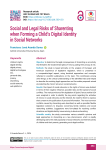
Social and Legal Risks of Sharenting when Forming a Child’s Digital Identity in Social Networks
Статья
Objective: to determine the legal consequences of sharenting as an activity that threatens the fundamental rights of minors, putting their privacy at risk. Methods: the study is based primarily on the analysis of European and American experience of legislative regulation, which is presented in a comparative-legal aspect, using doctrinal approaches and concepts reflected in scientific publications on the topic. This contributed, among other things, to the critical understanding of the identified risks and helped to describe the existing legal approaches and formulate proposals aimed at protecting the minors’ privacy in social networks. Results: the impact of social networks on the rights of minors was studied, in terms of their negative influence, possible risks and the spread of social conflicts. The main provisions of the legislation of Spain, France and the USA were analyzed in order to identify the key points regarding the activities of minors in social networks and the Internet, the need for them to express their consent to the publication of personal information. The most common conflicts caused by sharenting were described, as well as possible flexible legislative solutions to disputes concerning family relations and social networking activities. Suggestions were formulated for resolving conflict situations and digital identity issues arising in abusive sharenting. Scientific novelty: the study summarizes various scientific opinions and legal approaches to sharenting as a new phenomenon, which is rapidly developing due to the wide popularity of social networks and Internet activity of children and their parents, generating socio-legal conflicts. Practical significance: the research shows that minors are particularly vulnerable in the information and telecommunication environment. In many cases, excessive disclosure of their personal data occurs not only because of their own actions, but also because of the actions of their family members, usually parents. A comparative legal study of the adopted legislative measures and their interpretations in the legal doctrine allows characterizing the current legal situation with regard to minors in the digital space as fragmentary and proposing legislative approaches and solutions to avoid or minimize possible conflict situations and risks, such as digital harassment or privacy violation, which may arise in the process of further technological development and the spread of sharenting.
Бесплатно
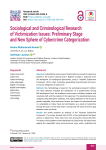
Статья
Objective: to identify the main issues of victimization as a result of cybercrime growth in the world in general and in Nigerian society in particular from the standpoint of sociological approaches, using a Tripartite Cybercrime Framework (TCF), which comprises geopolitical, psychosocial and socio-economic categories of cybercrime. Methods: the methodology is based on the sociological research method. The data collection included the distribution of a questionnaire among 896 participants from the academic environment, including students and university staff, and the analysis of the responses. The presented data were analyzed using descriptive statistics, with special attention to the issues of gender inequality, socio-economic factors, the impact of educational level on vulnerability to online fraud and victimization as a result of cybercrime through the prism of the ideal victim concept and the socio-economic gap between North and South. Results: the article presents an analysis of the Tripartite Cybercrime Framework. The survey showed that 65.20% of the participants had been victims of cybercrime. There were more men among the victims (64.69%). The authors found patterns in the distribution of cybercrimes. All cybercrimes against the respondent were socio-economic ones, which underlines the high frequency of cybercrime and the relevance of countering it in Nigerian society. Special attention was paid to the issues of gender inequality, socio-economic factors, and the impact of education on vulnerability to cybercrime. The article considers from the viewpoint of the ideal victim concept. The study results provide an idea of the prevalence and distribution of specific types of cybercrime in the socio-economic category among the studied population. Scientific novelty: For the first time, the study uses the Tripartite Cybercrime Framework (TCF) to study victimization as a result of cybercrime in Nigerian society. The research novelty is also due to the fact that the conceptual foundations of countering cybercrime that have developed in the global North are not fully applicable in Nigeria. Practical significance: the results obtained demonstrate the need to apply carefully calibrated gender-based, inclusive and contextual approaches to the development of a national legal policy to combat cybercrime. The results can be used to justify the law-making decisions which are being developed in the field of preventing and countering manifestations of cybercrime, as well as to form the basis for legal measures to protect cybercrime victims.
Бесплатно
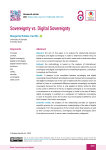
Sovereignty vs. Digital Sovereignty
Статья научная
Objective: the aim of this paper is to analyze the relationship between sovereignty and digital sovereignty in order to determine whether they are linked or autonomous concepts and in which cases and to what extent there is or is not a connection between the two categories. Methods: the methodology is based on the analysis of international, European and national practice and scientific discourse, taking into account sovereignty and digital sovereignty from a threefold perspective: contextual, conceptual and functional. Results: 1) analysis of the correlation between sovereignty and digital sovereignty showed that both are related concepts; 2) important consequences that digital sovereignty has in the case of States and the European Union are defined: a) there is a substantial difference between sovereignty and digital sovereignty because the former is only applied to States, while the latter is also used in reference to the EU; b) digital sovereignty is not necessarily a consequence or an extension of sovereignty; c) while in the case of States, digital sovereignty is justified as a safeguard of traditional sovereignty, in case of European Union its function must necessarily be different, since the European Union lacks sovereignty. Scientific novelty: the analysis of this relationship provides an objective scientific premise for a comprehensive understanding of the idea of digital sovereignty. From the perspective of the context where they operate, as well as their concept and functions, sovereignty and digital sovereignty seem to be autonomous and, in some cases, complementary categories. Practical significance: the dual functionality of digital sovereignty as a concept attached to national sovereignty and as an autonomous concept helps to explain the use of this category in the case of states and in the case of an organization such as the European Union, as well as the differences in its scope and meaning in each scenario.
Бесплатно
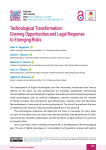
Technological Transformation: Growing Opportunities and Legal Response to Emerging Risks
Статья
Бесплатно
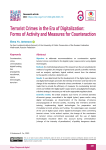
Terrorist crimes in the era of digitalization: forms of activity and measures for counteraction
Статья научная
Objective: to elaborate recommendations on counteraction against terrorist crimes committed in the digital (cyber-) space and/or using digital technologies. Methods: the methodological basis of the research are the universal dialectic method of cognition, the integrity of general and specific scientific methods such as analysis, synthesis, logical method, ascent from the abstract to the specific, induction, deduction, etc. Results: it was determined that the development of the digital (cyber-) space and digital technologies promotes the intensity of terrorism and has led to the change of the mechanism of terrorist crimes commitment. A conclusion was made that, to provide the efficiency of measures for counteracting terrorist crimes committed in the digital (cyber-) space and/or using digital technologies, a distinct strategy is necessary, as well as the appropriate regulatory basis. Scientific novelty: the article analyzes such forms of criminal activities of terrorist groups, committed in the digital (cyber-) space and/or using digital technologies, as dissemination of the ideology of violence and propaganda of terrorist activity, recruiting new members and their training, implementing digital technologies for preparation and immediate terrorist activity, and funding. The advantages were revealed of the use of digital space and/or digital technologies when committing terrorist crimes. In the author’s opinion, the change of the mechanism of terrorist crimes commitment associated with the use of digital technologies should be taken into account during criminalization (change of the intensity of penalization) of publicly dangerous deeds. The important areas of state policy in the sphere of counteraction against these crimes are education and enlightenment activity, training of the personnel of law-enforcement agencies, broadening their authorities to ensure a clear and effective control over digital content. Practical significance: is due to the possibility to use the formulated conclusions and proposals for further scientific elaboration of the state criminal policy in the sphere of counteraction against terrorist crimes committed in the digital (cyber-) space and/or using digita technologies.
Бесплатно
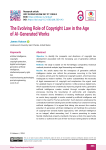
The Evolving Role of Copyright Law in the Age of AI-Generated Works
Статья
Objective: to identify the prospects and directions of copyright law development associated with the increasing use of generative artificial intelligence. Methods: the study is based on the formal-legal, comparative, historical methods, doctrinal analysis, legal forecasting and modeling. Results: the article states that the emergence of generative artificial intelligence makes one rethink the processes occurring in the field of creative activity and the traditional copyright system, which becomes inadequate to modern realities. The author substantiates the necessity of legal reassessment of copyright and emphasizes the urgent need for updated means of copyright protection. Unlike previous digital tools, which expanded human creativity by improving original works, generative artificial intelligence creates content through complex algorithmic processes, blurring the boundaries of authorship and originality. The research shows limitations of existing intellectual property law, as courts deny copyright in works created by artificial intelligence and insist on the need for “human authorship”. Such decisions emphasize the contradiction between existing laws and the reality of co-creation involving artificial intelligence. It is argued that taking into account the creative potential of generative artificial intelligence will facilitate the evolution of copyright law towards hybrid approaches, with artificial intelligence as an integral, albeit secondary, tool. It seems promising to create flexible intellectual property standards that give artists the opportunity to restrict or authorize the use of their works as training data for artificial intelligence, as well as ensure that authors retain control over their works included in datasets for training artificial intelligence, in case copyright metadata is integrated into digital works, etc. Scientific novelty: based on the analysis of the latest judicial precedents, modern international regulations and evolving institutional practices, the author proposes a balanced adaptive approach to copyright reform to ensure the ethical integration of generative artificial intelligence into the creative ecosystem and to develop flexible copyright protection measures that correspond to the rapid technological progress. Practical significance: the proposed combined approach will allow generative AI tools to become part of the human creative process in the same way that previous generations used digital tools. At the same time, it will contribute to the creation of an environment where the autonomy of authors is respected. This will not only protect the creators of creative content, but also broaden the understanding of creativity as a collaboration with generative artificial intelligence, where artificial intelligence is positioned as a force that complements but not replaces humans in creativity.
Бесплатно
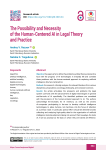
The Possibility and Necessity of the Human-Centered AI in Legal Theory and Practice
Статья научная
Objective: the paper aims to define the problems juridical theory and practice face with the progress of AI technologies in everyday life and correlate these problems with the human-centered approach to exploring artificial intelligence (Human-Centered AI). Methods: the research critically analyzes the relevant literature from various disciplines: jurisprudence, sociology, philosophy, and computer sciences. Results: the article articulates the prospects and problems the legal system confronts with the advancement of digital technologies in general and the tools of AI specifically. The identified problems are correlated with the provisions of the human-centered approach to AI. The authors acknowledge the necessity for AI inventors, as well as the owners of companies participating in the race to develop artificial intelligence technologies, to place humans, not machines, into the focus of attention as a primary value. In particular, special effort should be directed towards collecting and analyzing high-quality data for the organization of artificial intelligence tools development, taking into account that nowadays, the tools of AI are as practical as the data on which they are trained are effective. The authors formulate three principles of human-centered AI for the legal sphere: 1) a human as a necessary link in the chain of making and executing legal decisions; 2) the need to regulate artificial intelligence at the international law level; 3) formulating “a taboo” for introducing the artificial intelligence technologies. Scientific novelty: the article manifests one of the first attempts in the Russian-language scientific literature to outline the prospects of developing human-centered AI methodology in jurisprudence. Based on an analysis of special literature, the authors formulate three principles of including artificial intelligence into juridical theory and practice according to the assumptions of a human-centered approach to AI. Practical significance: the principles and arguments the article advances can be helpful in the legal regulation of artificial intelligence technologies and their harmonious inclusion into legal practices.
Бесплатно
The Rise of AI Avatars: Legal Personhood, Rights and Liabilities in an Evolving Metaverse
Статья
Objective: to determine the legal implications of the development of autonomous and creative AI-based avatars and to shape the direction of the discourse on the responsible management of AI technologies in the meta-universe based on proactive interdisciplinary approaches. Methods: the research is based on a doctrinal legal approach, which allowed presenting a prospective analysis of the legal landscape in the field of AI avatars in the metaverse and to identify four key thematic areas of research: the evolution of AI avatars and the impact of the metaverse, the applicability of legal personhood, the liability for autonomous actions, and the problems of AI avatars in the field of creativity related to intellectual property and privacy. Results: the paper presents and analyzes predictive scenarios of AI avatars maximizing their influence in the metaverse space. The author notes that the emergence of AI-based avatars in the metaverse raises complex legal, ethical, philosophical and social issues that require urgent solutions. The potential impact of the increasing complexity of AI avatars on legal approaches is considered. As avatars become increasingly autonomous, questions arise about their legal status, rights, responsibilities, risks, and benefits to humans and society. The author analyzes the advantages and disadvantages of giving AI avatars the status of legal entities, as well as applying the concept of distributed responsibility to the consequences of their actions. Special attention is paid to the possible future dominance of super-intelligent AI-based avatars in the metaverse, taking into account the existing risks and needs in the field of governance. Scientific novelty: the article presents a new perspective on the problem of legal personality in the metaverse based on interdisciplinary analysis of the evolution of AI avatars. The research is aimed at achieving a balance between transformational potential and the protection of human rights and welfare through joint efforts. It is proposed to create legal and ethical norms that prioritize the safety and consistency of artificial intelligence technologies involved in the processes occurring in the metaverse. Practical significance: the conclusions and proposed solutions to the legal problems of personhood and liability can become the basis for revising the concept of legal personality, developing reliable mechanisms of responsibility and accountability, as well as ensuring the protection of human rights and values in the face of increasingly powerful entities based on artificial intelligence. This is associated with the formation and improvement of the legal landscape of process management and overcoming risks in the socially oriented and inclusive ecosystem of the metaverse.
Бесплатно

Towards Legal Regulations of Generative AI in the Creative Industry
Статья
Objective: this article aims to answer the following questions: 1. Can generative artificial intelligence be a subject of copyright law? 2. What risks the unregulated use of generative artificial intelligence systems can cause? 3. What legal gaps should be filled in to minimize such risks? Methods: comparative legal analysis, sociological method, concrete sociological method, quantitative data analysis, qualitative data analysis, statistical analysis, case study, induction, deduction. Results: the authors identified several risks of the unregulated usage of generative artificial intelligence in the creative industry, among which are: violation of copyright and labor law, violation of consumers rights and the rise of public distrust in government. They suggest that a prompt development of new legal norms can minimize these risks. In conclusion, the article constants that states have already begun to realize that the negative impact of generative artificial intelligence on the creative industry must not be ignored, hence the development of similar legal regulations in states with completely different regimes. Scientific novelty: the article provides a comprehensive study of the impact of generative artificial intelligence on the creative industry from two perspectives: the perspective of law and the perspective of the industry. The empirical basis of it consists of two international surveys and an expert opinion of a representative of the industry. This approach allowed the authors to improve the objectivity of their research and to obtain results that can be used for finding a practical solution for the identified risks. The problem of the ongoing development and popularization of generative artificial intelligence systems goes beyond the question “who is the author?” therefore, it needs to be solved by introduction of other than the already existing mechanisms and regulations – this point of view is supported not only by the results of the surveys but also by the analysis of current lawsuits against developers of generative artificial intelligence systems. Practical significance: the obtained results can be used to fasten the development of universal legal rules, regulations, instruments and standards, the current lack of which poses a threat not only to human rights, but also to several sectors within the creative industry and beyond.
Бесплатно
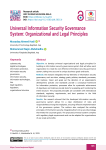
Universal Information Security Governance System: Organizational and Legal Principles
Статья
Objective: to develop universal organizational and legal principles for building an information security governance system that will allow each organization to create its own effective information security governance system, taking into account its unique business goals and tasks. Methods: the research integrates the key elements of information security governance, such as vision, strategy, goals, policies, standards, processes, and matrices. Vision and goals set the direction of an organization’s development; policies and standards provide a conceptual framework for information protection; processes allow for systematic achievement of objectives; and matrices provide tools for evaluating and monitoring the entire structure. The proposed principles are consistent with international standards, regulatory requirements, and best practices in the field of information security. Results: the research showed that the developed information security governance system allows for a clear distribution of roles and responsibilities among the employees, ensuring effective implementation of the governance system. The authors also analyzed the existing principles of information security, integrating them into a security strategy that meets the corporate goals. The proposed universal system complies with regulatory legal requirements and can be adapted for organizations of any scale and profile. Scientific novelty: the paper represents a practical approach to the implementation of an information security governance system based on the authors’ experience, international standards, control systems and legal acts. Unlike existing approaches, the proposed system is flexible and can be adapted to any organization, which makes it a universal tool for information security governance. Practical significance: the research provides a structured approach to creating a universal information security governance system that can be used by organizations lacking knowledge and resources to implement such initiatives. The authors propose a general structure that can be adapted depending on the organization’s assets, the employees’ training and awareness of information security issues. This makes the paper a valuable resource for professionals seeking to increase information security in their organizations.
Бесплатно
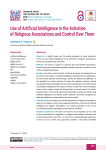
Use of Artificial Intelligence in the Activities of Religious Associations and Control Over Them
Статья
Objective: to identify gaps and formulate proposals on legal regulation of the use of artificial intelligence in the activities of religious associations and control (supervision) over them. Methods: the study is based on sectoral and risk-oriented approaches, formal-logical and comparative general scientific methods, as well as on the method of legal forecasting. Results: the author noted similarity of ethical principles formulated all over the world in the sphere of artificial intelligence development and application, as well as their general shortcomings, namely, the lacking consideration of the specificity in certain spheres of human life (religious sphere), cultural peculiarities, historical development of a country and people. The shortcomings of principles stipulated by the codes of ethics include their recommendatory nature, which creates a basis for abusing them in certain cases. The author proposes that if control and supervisory authorities caused harm while using artificial intelligence, the relevant public authority should be recognized as liable and obliged to compensate for the harm caused. Scientific novelty: the paper summarizes the practice of religious associations using AI, formulates current and prospective directions of the use of artificial intelligence by religious associations, and makes proposals for the AI use in controlling (supervising) religious associations’ activities. Practical significance: the main conclusions and proposals can be used for the improvement of legislation on religious associations’ activities and control (supervision) over them, as well as for developing legal regulation of the AI use in control and supervision activities. The author identified the possibilities for religious associations using AI to popularize religion, inform about their activities, manage property, analyze sacred texts to improve their understanding and interpretation, as well as for conducting scientific research, systematization and accumulation of information, preservation of cultural heritage, and educational activities. The use of artificial intelligence in controlling the religious associations’ activities can reduce the period of religious organizations’ registration and inspections and optimize the work of control bodies, including by monitoring the religious situation.
Бесплатно
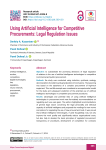
Using Artificial Intelligence for Competitive Procurements: Legal Regulation Issues
Статья научная
Objective: to substantiate the promising directions of legal regulation of relations in the use of artificial intelligence technologies in competitive (commercial and public) procurement. Methods: the study was conducted using induction, synthesis, analogy, decomposition of problems and generalization of conclusions. The reasoning was based on the experience of a complex procurement of high-tech equipment. This real-life example was considered as an experimental model for the study and subsequent prediction of the potential use of artificial intelligence technologies in competitive procurement procedures. Results: advantages and potential risks of using artificial intelligence technologies in procurement work were formulated; recommendations on regulating such use were given. The authors highlighted recommendations of general legal nature concerning the legal personality and delictual capacity of artificial intelligence and proposed the wordings for new norms and options for regulating the use of new procurement tools. It was proved that artificial intelligence technologies, if used thoughtfully, may not only improve the work quality and significantly reduce organizational costs, but also help to develop the basic principles of regulated procurement: transparency of procedures, development of competition for contracts between qualified suppliers, reasonableness of decisions, and economic efficiency of the customer’s expenditures. Scientific novelty: despite a large number of works devoted to both the problems of artificial intelligence in general and its use in procurement in particular, the article considers this topic on the basis of mainly inductive reasoning, built on handling a particular case and experience of complex procurement for knowledge-intensive research, refracted through the prism of essential correlation between the basic concepts of “digitalization”, “automation”, “robotization” and so on. Practical significance: the directions of using artificial intelligence described in this paper can be implemented by corporate and, in the future, by public customers to improve the quality of their procurement. At the same time, the recommendations on the normative regulation of such innovation seem to be in demand both at the legislative and local levels.
Бесплатно

Using Artificial Intelligence in Employment: Problems and Prospects of Legal Regulation
Статья научная
Objective: to identify the legal problems of using artificial intelligence in hiring employees and the main directions of solving them. Methods: formal-legal analysis, comparative-legal analysis, legal forecasting, legal modeling, synthesis, induction, deduction. Results: a number of legal problems arising from the use of artificial intelligence in hiring were identified, among which are: protection of the applicant’s personal data, obtained with the use of artificial intelligence; discrimination and unjustified refusal to hire due to the bias of artificial intelligence algorithms; legal responsibility for the decision made by a generative algorithm during hiring. The author believes that for the optimal solution of these problems, it is necessary to look at the best practices of foreign countries, first of all, those which have adopted special laws on the regulation of artificial intelligence for hiring and developed guidelines for employers using generative algorithms for similar purposes. Also, the European Union’s and USA’s legislative work in the area of managing risks arising from the use of artificial intelligence should be taken into account. Scientific novelty: the article contains a comprehensive study of legal problems arising from the use of artificial intelligence in hiring and foreign experience in solving these problems, which allowed the author to develop recommendations to improve Russian legislation in this area. As for the problem of applicants’ personal data protection when using artificial intelligence for hiring, the author proposes to solve it by supplementing the labor legislation with norms that enshrine the requirements for transparency and consistency in the collection, processing and storage of information when using generative algorithms. The list and scope of personal data allowed for collection should be reflected in a special state standard. The solution to the problem of discrimination due to biased algorithms is seen in the mandatory certification and annual monitoring of artificial intelligence software for hiring, as well as the prohibition of scoring tools for evaluating applicants. The author adheres to the position that artificial intelligence cannot “decide the fate” of a job seeker: the responsibility for the decisions made by the algorithm is solely on the employer, including in cases of involving third parties for the selection of employees. Practical significance: the obtained results can be used to accelerate the development and adoption of legal norms, rules, tools and standards in the field of using artificial intelligence for hiring. The lack of adequate legal regulation in this area creates significant risks both for human rights and for the development of industries that use generative algorithms to hire employees.
Бесплатно
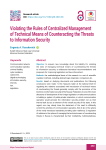
Статья научная
Objective: to acquire new knowledge about the liability for violating the rules of managing technical means of counteracting the threats to information security; to elaborate theoretical recommendations and proposals for improving legislation and law enforcement. Methods: the methodological basis of the research is a set of scientific cognition methods, including abstract-logic, dogmatic, comparison, etc. Results: based on studying documents and publications, the following conclusions were made: 1) the measures taken at the national level for regulating the relations associated with introduction of technical means of counteracting the threats generally comply with the provisions of the Doctrine on information security of the Russian Federation; 2) one of the main directions of development of the foreign legislation on telecommunications is building a system of public-private interaction, in which communication operators would perceive the information security problem not as their internal task but as an element of the overall security of the state. In this regard, one may clearly trace the statement of the need to efficiently control the activities of communication operators, first of all, in the sphere of the newly introduced standards providing cyber resilience; 3) regulation of relations in the sphere of managing the technical means of counteracting threats in Russia is characterized by their multiplicity, multi-leveledness, hence, rather predictable complexity; 4) the model of communication operators’ liability for violations in the field of exploitation of technical means of counteracting threats, implemented in Article 274.2 Of the Russian Criminal Code, is not optimal. Rather disputable is the approach to describing the administratively prejudicial elements of crime. Despite the significance of the relations, the possibility of a criminal-legal reaction to a particular incident appears not in connection with the occurrence of certain publicly dangerous consequences and not even with the traditional recurrence, but only with the third documented violation. We consider more preferable the model of criminalization of violating the management of technical means of counteracting threats depending on infliction of substantial harm to the rights and legal interests of citizens or organizations, or the legally protected interests of the society or the state. Scientific novelty: the novelty of the research is mainly due to the actual underdevelopment of the issues related to the legal definition and implementation of criminal liability for violating the rules of centralized management of technical means of counteracting the threats to sustainability, security and integrity of functioning of the telecommunication network Internet and the general purpose communication network in the territory of the Russian Federation. Practical significance: the main provisions and conclusions of the research can be used for improving the mechanism of criminal-legal protection of information security, further development of the Russian doctrine of criminal law on liability for crimes in the sphere of computer information.
Бесплатно

